Latest Posts by alitheastronomer - Page 3
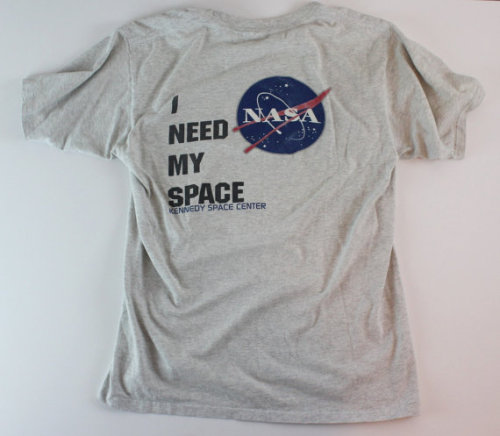

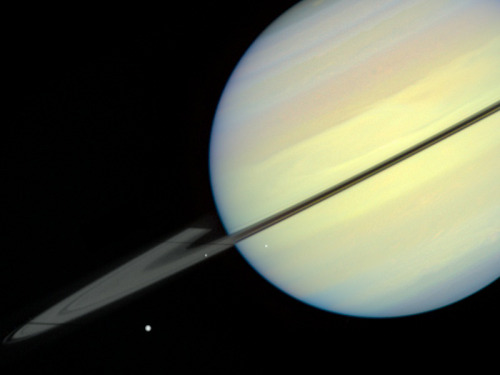
The planet Saturn, observed by the Hubble Space Telescope.
Well now I know what I would be doing if I won the lottery...

So you want to go to space ?
It suddenly struck me that that tiny pea, pretty and blue, was the earth. I put my thumb and covered one eye and my thumb blotted out the planet earth.
- Neil Armstrong
And ergo ‘Space’ became a part of my vocabulary from a very young age. All that i wanted to do was to become an astronaut and wander the oblivion space that lies beyond our wildest comprehension.

But how much is the ticket?!?
I hear if you try to buy it on a Tuesday at 2am you will get a GREAT fare!
Alright all jokes aside space travel is becoming available to regular citizens, well maybe regular isn’t the right word, wealthy citizens.

But just how wealthy do you need to be? How many banks should you plan on robbing before you pack your bags?
Well it depends on where you are going. ;)
Do you want to go on a spaceplane?

This is at about 60 miles above the Earth’s surface.
If Virgin Galactic does continue with SpaceShipTwo they had set their cost at $250,000 or about 6 bank robberies.
(Since the crash of an earlier version of SpaceShipTwo (due to pilot error) they are instead shifting their time and money towards practical launchers. HOW LAME!!)
If XCOR finishes up the Lynx they have set their ticket cost at $100,000 or 3 bank robberies.
But what about a trip to the International Space Station (ISS)?

Well I have good news for you because private citizens have already paid for trips there. No waiting around for a spaceplane to be built.
Space Adventures has put people in space since 2001. They make the travel arrangements for civilians to ride the Russian Soyuz capsule to the space station.
The cost is over $20 million or 435 bank robberies.
How about walking in space?

For an extra $15 million (327 bank robberies) Space Adventures will organize for you to do a spacewalk during your stay on the ISS.
If this all seems a little too pricey for you maybe you should think about the space simulators!!

Zero Gravity Corporation sells tickets on NASA’s “Vomit Comet” (a plane that makes you feel like you are weightless) for $136,000 BUT it is for you and 35 of your closest friends!
Talk about a party!!!

They do offer for you to pay an individual price but that all is on a case by case business. However if you are a struggling student I have some good news for you.

NASA offers undergraduate students the opportunity to conduct experiments on reduced gravity flights. They also have flights for educators too so definitely check out their programs!!
Did you enjoy the post?
If you did, please take a second to follow the author - Marielle ( A Rocket Scientist )

who runs her own website - missaerospace / on twitter and also has her own tumblr. Her posts truly appeal to the space geek in every one of us.
Have a good day!
PC: Dangerouslee Space.com Oleg Kotov Takes a Picture During a Spacewalk by NASA Johnson

Jupiters Great Red Spot is likely a sunburn, not a blush. New science from NASAs Cassini Mission to Saturn based on lab and flyby data.
js
Phase of the moon affects amount of rainfall
Seattle WA (SPX) Jan 31, 2016 When the moon is high in the sky, it creates bulges in the planet’s atmosphere that creates imperceptible changes in the amount of rain that falls below. New University of Washington research to be published in Geophysical Research Letters shows that the lunar forces affect the amount of rain - though very slightly. “As far as I know, this is the first study to convincingly connect t Full article




Four beautiful examples of overlapping/interacting galaxies brought to you by the Hubble Telescope. To view the images in their full resolutions, please open them in a separate tab.

The Space Shuttle Columbia
Pause today to remember the Crew of STS-107, who all died on this day 13 years ago, February 1, 2003, when the Space Shuttle Columbia became unstable and disintegrated on re-entry over Texas. The Crew:
The Flight Commander was Rick D. Husband, a U.S. Air Force colonel and mechanical engineer, who piloted a previous shuttle during the first docking with the International Space Station on STS-96.
The Pilot was William C. McCool, a 1983 graduate of the United States Naval Academy in Annapolis, Maryland and U.S. Navy commander.
The Payload Commander was Michael P. Anderson, a U.S. Air Force lieutenant colonel. He was also a physicist and mission specialist who was in charge of the science mission.
The Payload Specialist Ilan Ramon was a colonel in the Israeli Air Force and the first Israeli astronaut.
The Mission Specialist was Kalpana Chawla, an Indian-born aerospace engineer who was on her second space mission. She was the first Indian woman in space.
The Mission Specialist was David M. Brown, a U.S. Navy captain trained as an aviator and flight surgeon.
The Mission Specialist was Laurel Blair Salton Clark, a U.S. Navy captain and flight surgeon. Clark worked on biological experiments.
The Space Shuttle Columbia was named after the poetic designation for the United States of America. This poetic name (based on Christopher Columbus, thought then as the sole discoverer of America) was meant to be both inclusive and a little bit nostalgic, in the sense that America could be embodied in a name. Clearly these seven astronauts and mission specialists embodied the best spirit of America, the inclusion of an Indian and Israeli the strongest symbol yet of what America can accomplish when unified to a common purpose. Special thought to William McCool, graduate of the USNA-I pass almost daily the ‘McCool Marker’, a memorial on the grounds of the USNA golf course to celebrate his achievements both as a Naval Aviator but also his accomplishments as a Midshipman, where he served as Captian of the Cross Country team his senior year. The marker is placed on the cross country course 16 minutes from the finish line of his fastest run on the Navy course.
What’s Up for February 2016?
Five morning planets, Comet Catalina passes Polaris and icy Uranus and icy Vesta meet near Valentine’s Day.

February mornings feature Mercury, Venus, Saturn, Mars and Jupiter. The last time this five-planet dawn lineup happened was in 2005. The planets are easy to distinguish when you use the moon as your guide. Details on viewing HERE.
If you miss all five planets this month, you’ll be able to see them again in August’s sunset sky.

Last month, Comet Catalina’s curved dust tail and straight ion tail were visible in binoculars and telescopes near two galaxies that are close to the handle of the Big Dipper. Early this month, the comet nears Polaris, the North Star. It should be visible all month long for northern hemisphere observers.

There will be more opportunities to photograph Comet Catalina paired with other objects this month. It passes the faint spiral galaxy IC 342 and a pretty planetary nebula named NGC 1501 between Feb. 10 – 29. For binocular viewers, the magnitude 6 comet pairs up with a pretty string of stars, known as Kemble’s Cascade, on Feb. 24.

Finally, through binoculars, you should be able to pick out Vesta and Uranus near one another this month. You can use the moon as a guide on Feb. 12, and the cornerstone and the corner stars of Pegasus all month long.

For more information about What’s Up in the February sky, watch our monthly video HERE.
Make sure to follow us on Tumblr for your regular dose of space: http://nasa.tumblr.com


30 Doradus, located in the heart of the Tarantula nebula, is the brightest star-forming region in our galactic neighborhood. The nebula resides 170,000 light-years away in the Large Magellanic Cloud.
js
Having high def pictures of all of them is so satisfying. Bye bye blurry pictures of Pluto 😁


The loneliest of galaxies

Arp 87:
NGC 3808A (right) & NGC 3808B (left)
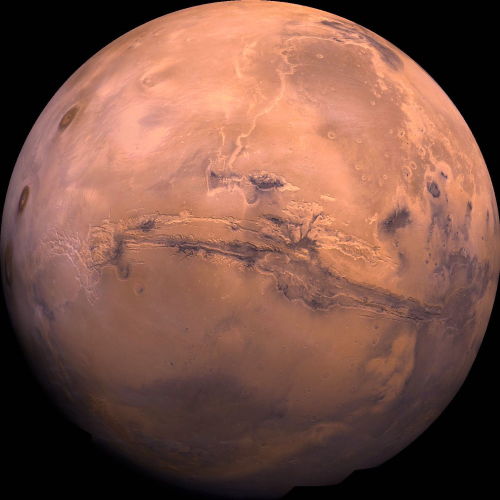
It's amazing how these galaxies, that are so unfathomably huge to us, are actually really fragile and delicate in the scheme of things
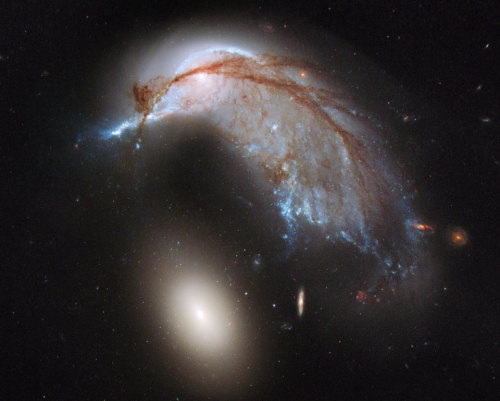
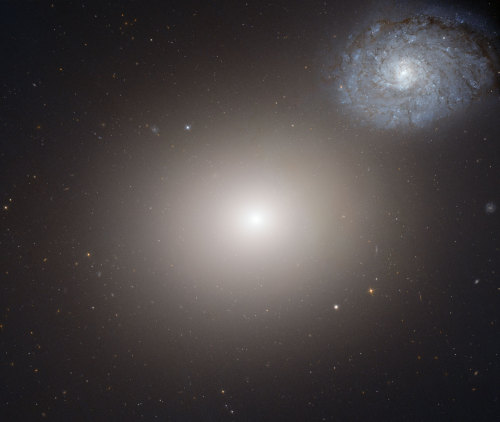
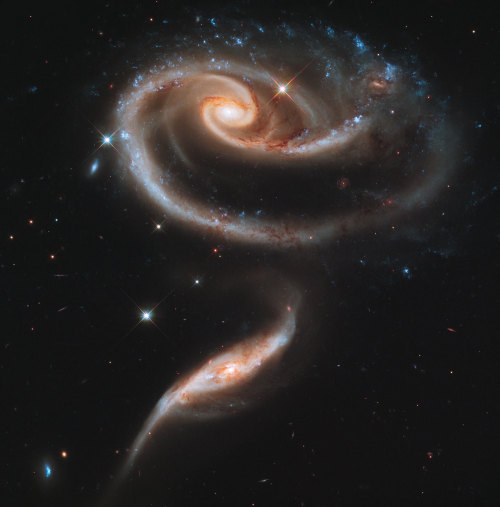
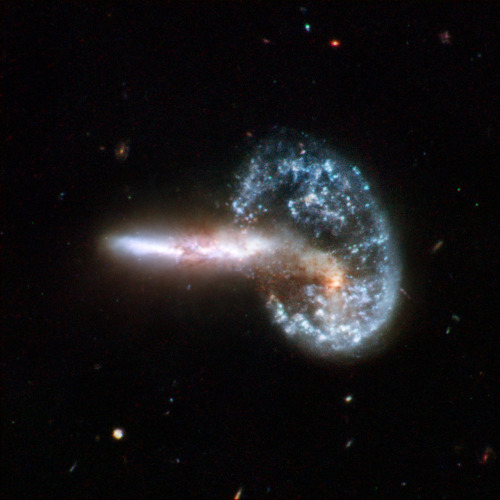

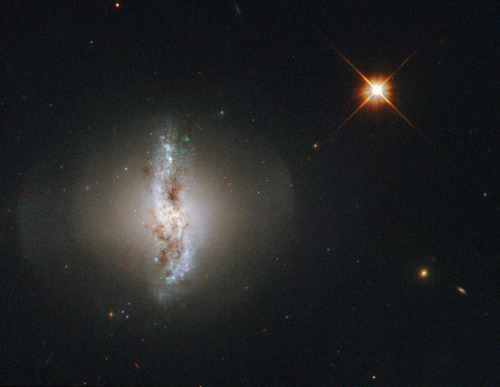
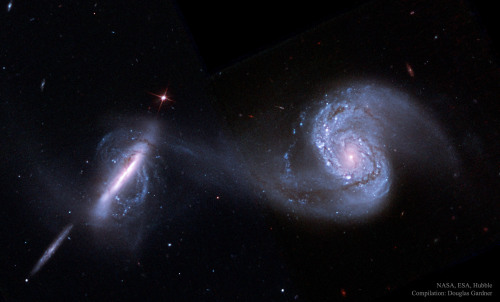



Top 10 Bizarre Galaxy Pairs From Hubble
“The Arp catalog illustrates galaxies in many different stages of a collision:
* prior to their first close pass, * in the collision process, * subsequent to an interaction but before merging, * and in the final merger stages.
Unlike ellipticals, spirals are easily disturbed, often becoming destroyed entirely by such an interaction.”
When you take a glimpse into the deep Universe, beyond the gas, dust, stars and planets of our own galaxy, you enter the realm of the galaxies. In general, they come in two types: the spirals, with neat, orderly arms, and the ellipticals, with a symmetric, bulging shape. But for everything that exists in the Universe a particular way in general, there are exceptions. In the 1960s, astronomer Halton Arp became fascinated with these exceptions, creating a catalog of 338 examples: the Atlas of Peculiar Galaxies. We now know that most of these are galaxy pairs or triplets in the process of major mergers, displaying features such as tidal disruption, stellar bridges, starbursts and occasionally a rare, ring shape.
I love how stars are billions of miles apart and we’re like “that’s a soup ladle”.

Favourite APOD of 2015, #10 (October): A Gegenschein Lunar Eclipse
There’s so much going on in this photo! The Gegenschein is the faint, blueish glow you can see rising from the horizon and going behind the eclipsed Moon.
Runner-ups:

The Witch Head Nebula

Starburst Galaxy Messier 94

Caldwell 24, NGC 1275, Perseus A | May 1, 2003




Cassini, Jupiter and Saturn

Have gravitational waves been found?
Excited rumors began circulating on Twitter this morning that a major experiment designed to hunt for gravitational waves—ripples in the fabric of spacetime first predicted by Albert Einstein—has observed them directly for the very first time. If confirmed, this would be one of the most significant physics discoveries of the last century.




SpaceX Lands the Faclon9 First Stage - A revolution in Rocket Science and Engineering
Today, at 8:33, Spacex made history. They landed the first stage of their Falcon9 rocket after having it successfully deploy a second stage into low earth orbit.
The Video is here:
Unlike other rocket companies, Spacex in not making small hops - they did that 2 years ago with their grasshopper rocket. In fact, this is how they tested the initial avionics systems that would be able to land the rocket in a stable position autonomously. Here is some footage:
Unlike the companies that makes these hops, Spacex has to use this stage to help get payloads into low earth orbit… and then recover it! This is incredibly difficult and requires an advanced retro-trusting maneuver that has never been successful - until now! The diagram below shows this trusting maneuver, which happens shortly after the second stage has decoupled and ignited.

Spacex claims that this is similar to trowing a pencil over the Empire State Building, then having it flip perfectly, then have it fall into a shoebox… easy enough right?

Only, in real life SpaceX isn’t shooting a pencil… they are shooting a rocket! This is the pad that the now famous falcon9 rocket landed on:

Now you might ask, why does this matter? This means space will become cheaper! We can already build satellites that are less than $10,000, as a matter of fact I’m building a small satellite with a team right now! As it currently stands, space travel is too expensive for creative people to take risks. Now, thanks to SpaceX, we may be mining or visiting asteroids, visiting the moon, visiting mars, or doing something crazier - and we may be doing this very soon! The Falcon9 rocket costs $54 million to build but only $200,000 to refuel… let’s put this in perspective… That’s the same amount that it costs to refuel a Boeing 747 (which is the airplane that consumers use to fly around the world). This means that space travel could be as cheap as air travel very soon! Way to go SpaceX!
If you want to watch the full launch and landing video check it out here (this may be moved in the future): http://www.spacex.com/webcast/

Credit: SpaceX

Picture I took of the milky way while in New Mexico. Straight up on my D3000 with a tripod

Transit of Venus(2012) through rain clouds. Canon T3i with 100-400 mm EF lens.





A Montage of the Carina Nebula
The Carina Nebula (known by astronomers as NGC 3372) is sometimes called the Great Nebula in Carina or the Grand Nebula. These images taken by the Hubble space telescope show the magnificent structure within the Carina Nebula. These images contain regions of dense star formation, interstellar winds, massive particle clouds and much more. Many of these structures are hundreds of light-years across and make the size of our solar system look pathetic in comparison. The Carine Nebula is about 10,000 light-years away from earth and is located in the constellation Carina.
Credit: NASA/ESA/Hubble










Striking views of our Solar System
Otherworlds: Visions of our Solar System can be seen at the Natural History Museum, London, from 22 January - 15 May 2016.
All credits on the link above
Courtney’s Big Space Book Recommendation Post
Okay, so, hi. It has come to my attention that I have gained a lot - a lot - of followers over the last few weeks due to hype for The Martian. Rad.
So, with that in mind, I’ve decided to put together a bunch of non-fiction space recommendations for y’all. Since an anon asked a few days ago, and I kindof want to do it more justice.
If you are new to me and my blog, you might not be aware that I am a gigantic fucking nerd for human space flight and exploration, and I have a boatload of dumbass blogs about it. So, uh, I’ve read a lot of books. Like, lots.
Keep reading
Well you're not wrong
true space facts
if u look up there it is
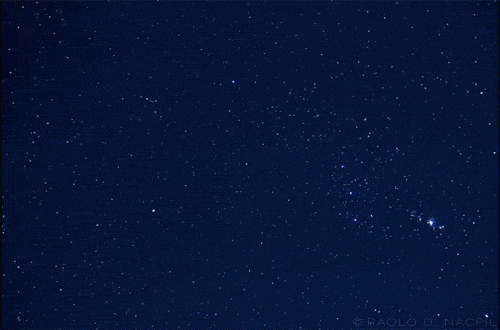

#Space: Arp 256, a stunning system of 2 #spiral #galaxies in early stage of #merging http://ift.tt/1CMu20M via @esa
This is probably the most majestic playlist I've ever heard.


LEAVING EARTH. “When once you have tasted flight, you will forever walk the earth with your eyes turned skyward, for there you have been, and there you will always long to return.” For courageous travellers. Go forth and explore. [listen]